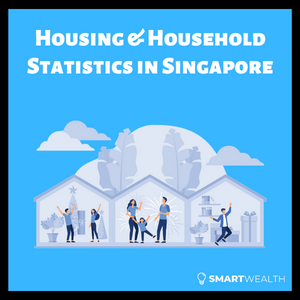Statistics concerning households are indispensable when it comes to understanding the way people in Singapore live. Most young Singaporeans live with their parents well into adulthood or until marriage, which makes it particularly easy to draw accurate conclusions from household data.
That could be one reason the government collects such extensive data on households. In this article, we go over some notable statistics about households and housing in Singapore. If you want to know the average household income in Singapore, click here instead.
Note: All figures are in Singapore dollars (SGD).
Top Housing & Household Statistics in Singapore (2024)
- The home ownership rate in Singapore was 89.7% (or 9 in 10) in 2023
- 77.8% of Singapore residents live in HDB flats (public housing)
- 17.2% of Singapore residents live in condos
- 4.8% of Singapore residents live in landed properties
- The number of resident households in Singapore was 1,425,100 in 2023, an increase of 21.3% over the past 10 years
- The average household size was 3.11 persons in 2023
- The proportion of married couples with children has decreased sharply over the last ten years, while that of married couples without children and one-person households has increased
SIDE NOTE When was the last time you conducted thorough financial planning or reviewed your finances? In this day and age in Singapore, doing so will absolutely improve the quality of life for you and your loved ones. Here are 5 reasons why financial planning is so important.
Number of Households
The number of resident households in Singapore was 1,425,100 in 2023.
| 2023 | 2022 | 2021 | 2020 | 2019 | 2018 | 2017 | 2016 | 2015 | 2014 | 2013 | 2012 | |
| Resident Households | 1,425,100 | 1,399,600 | 1,390,600 | 1,372,600 | 1,372,400 | 1,325,300 | 1,289,900 | 1,263,600 | 1,225,300 | 1,200,000 | 1,174,500 | 1,152,000 |
As can be seen in the above table, the number of households in Singapore has risen steadily year-on-year since 2013.
Over the 10-year period from 2013 to 2023, the total number of households increased by 21.3%. This is in line with Singapore’s overall upward trend of resident population growth.
The steady increase in the number of resident households could be one of the forces driving the consistent growth in demand for housing, which has caused property prices to rise considerably over the past decade and has resulted in an unprecedented number of HDB resale flats being sold for over $1 million.
Average Household Size
The average number of people per resident household was 3.11 persons in 2023.
| 2023 | 2022 | 2021 | 2020 | 2019 | 2018 | 2017 | 2016 | 2015 | 2014 | 2013 | 2012 | |
| Average Household Size Among Resident Households (Persons) | 3.11 | 3.09 | 3.15 | 3.22 | 3.16 | 3.24 | 3.3 | 3.35 | 3.39 | 3.43 | 3.47 | 3.53 |
The above data indicates that household sizes are shrinking, with year-on-year decreases being recorded almost every year from 2013 to 2023.
The decline can be partly attributed to low birth rates and a growing preference amongst couples to have fewer or no children.
Incidentally, the lowest total fertility rate ever recorded in Singapore was registered in 2022 at just 1.04, significantly lower than the previous record low of 1.1, recorded in 2020. It is thus probable that household size will continue to decline in the near future.
Households by Household Size
In 2023, 2-person households were the most common type of household, followed by 3-person households and 4-person households.
| Number of Households | |
| 1-Person Households | 222,700 |
| 2-Person Households | 344,200 |
| 3-Person Households | 315,500 |
| 4-Person Households | 287,100 |
| 5-Person Households | 156,500 |
| 6-Person Households Or Larger | 99,200 |
We can extrapolate that 2-person households would be composed largely of couples without children, or empty nesters whose children have grown up and left home.
Based on the above data, it is clear that the majority of households comprise a relatively low number of people. By contrast, only 7.0% of households are composed of 6 or more people, indicating a clear preference for smaller family sizes.
DID YOU KNOW? According to a survey conducted by MoneySense, about 3 out of 10 Singapore residents aged 30 to 59 had not started planning for their future financial needs. This isn't surprising because personal finance can seem complicated and daunting. But really, there are only a few things that you should focus on. Learn how to significantly improve your personal finances with the 7-step "wedding cake" strategy today.
Households by Living Arrangement
Most households in Singapore are occupied by married couples, the majority of which have children.
| Number of Households | |
| Married Couple-Based With Children | 662,000 |
| Married Couple-Based Without Children | 255,500 |
| Lone Parent | 83,000 |
| Living Alone | 222,700 |
| Others | 201,900 |
These findings would suggest that having children is still the default choice for couples. However, a closer look at the following breakdown would suggest that this trend is being reversed quite rapidly.
| Proportion of Total Households in 2023 | Proportion of Total Households in 2013 | Difference in Proportion | |
| Married Couple-Based With Children | 46.5% | 56.7% | -10.2% |
| Married Couple-Based Without Children | 17.9% | 14.5% | 3.4% |
| Lone Parent | 5.8% | 7.5% | -1.7% |
| Living Alone | 15.6% | 10.6% | 5% |
| Others | 14.2% | 10.6% | 3.6% |
Comparing the 2013 data with that recorded for 2023, it is clear that the proportion of married couples with children has decreased sharply over the last ten years, while that of married couples without children has increased. The number of one-person households has also increased, indicating that there is a growing number of singles opting to move out of their parents’ homes.
These findings are consistent with the trend of married couples choosing not to have children, as well as an increase in the number of singles delaying or forgoing marriage.
As far as singles are concerned, the data also indicates a growing desire to channel resources into living independently from one’s parents. This is in spite of government housing policies which make it easier for couples to obtain subsidised housing, and could previously have forced more singles to continue living with their parents until meeting a suitable partner with whom to found a household.
Percentage of Singaporeans Owning a Home
The home ownership rate in Singapore was 89.7% in 2023.
| 2023 | 2022 | 2021 | 2020 | 2019 | 2018 | 2017 | 2016 | 2015 | 2014 | 2013 | 2012 | |
| Resident Households (Number) | 1,425,100 | 1,399,600 | 1,390,600 | 1,372,600 | 1,372,400 | 1,325,300 | 1,289,900 | 1,263,600 | 1,225,300 | 1,200,000 | 1,174,500 | 1,152,000 |
| Owner-Occupied (Number) | 1,277,800 | 1,249,700 | 1,236,900 | 1,206,000 | 1,240,600 | 1,205,800 | 1,170,200 | 1,149,100 | 1,112,400 | 1,083,400 | 1,062,500 | 1,038,200 |
| Rented (Number) | 132,000 | 131,700 | 134,800 | 152,100 | 122,500 | 112,400 | 109,800 | 107,600 | 106,200 | 109,800 | 105,700 | 106,800 |
| Proportion Of Owner-Occupied Resident Households (Per Cent) | 89.7 | 89.3 | 88.9 | 87.9 | 90.4 | 91 | 90.7 | 90.9 | 90.8 | 90.3 | 90.5 | 90.1 |
Over the past 10 years, the home ownership rate has hovered at around 90% (or 9 in 10), which is one of the highest home ownership rates in the world. In contrast, only 9.3% of households rented in 2023.
This data does not, however, mean that 89.7% of Singapore residents owned a home in 2023, but rather that 89.7% of resident households were living in owned rather than rental accommodation. Young Singapore residents living in homes owned by their parents would thus not bring down the home ownership rate, despite not being homeowners themselves.
The overwhelming and enduring preference for buying over renting can be explained in part by the Central Provident Board (CPF) system, which deducts a significant portion of salaries each month to be set aside for retirement and medical needs. A portion of CPF savings can be used for housing purchases but not rent, thus incentivising residents to buy rather than rent.
The high home ownership rate illustrates that the majority of young Singaporeans still prefer to live in the family home until they are able to purchase a home of their own, rather than turn to the rental market.
Percentage of Singaporeans Living in HDB, Condo, and Landed Homes
There are three main housing types in Singapore, as follows:
- Housing Development Board (HDB) flats – Subsidised public housing, usually high-rise
- Condos – Private apartment-style housing, usually high-rise and with shared facilities
- Landed homes – Usually private houses attached to a piece of land
Although there are some exceptions to the public-private division, HDB flats are generally considered a form of public housing, while most condos and landed homes are classified as private housing.
| Number of Households | |
| Resident Households | 1,425,100 |
| – Total HDB Dwellings | 1,108,100 |
| HDB 1- And 2-Room Flats | 99,700 |
| HDB 3-Room Flats | 242,900 |
| HDB 4-Room Flats | 446,600 |
| HDB 5-Room And Executive Flats | 319,000 |
| – Condominiums And Other Apartments | 244,800 |
| – Landed Properties | 68,400 |
| – Other Types Of Dwelling | 3,800 |
Based on the above breakdown, it can be seen that the majority of Singapore residents (77.8%) live in HDB flats. Given the generous government subsidies for HDB flats and the much lower prices of public housing compared to private, it is unsurprising that those who qualify for HDB flat purchases tend to opt for them.
17.2% of Singapore residents live in condos and other private apartments, while 4.8% live in landed homes. Private housing is much more expensive to buy or rent than HDB flats, so it comes as no surprise that only an affluent minority can afford to live in such homes. The small number of households living in landed homes is an indication of the rarity of this type of accommodation in land-scarce Singapore, as well as the larger size of such homes, which results in higher prices.
Only 0.2% live in other types of dwellings, which remain rare.
Of those who live in HDB flats, a majority reside in 4-room HDB flats, making it the most common flat type in Singapore, followed by 5-room, 3-room, 1-room and 2-room flats.
In Conclusion
Singapore’s severely low fertility rate continues to decline and has been accompanied in tandem by a decrease in average household size. More singles and married couples are choosing not to have children, a trend which appears to be intensifying ever more with time.
The low fertility rate continues to pose an economic challenge, particularly because of Singapore’s heavy reliance on human capital. The government’s response has been to depend on immigration and naturalisation to continue to grow the population.
As for housing in Singapore, home ownership rates remain high due to HDB grants, as well as the CPF system which requires Singaporeans and PRs to make contributions which can later be used to pay for property purchases.
However, as prices of housing continue to climb, many young Singaporeans who have not yet entered the property market have serious doubts about whether they will be able to afford a home someday. The government intervenes from time to time with cooling measures to bring down property prices, but they nonetheless continue to trend steadily upwards.
Methodology
The above data only tracks resident households. A resident household is defined as a household where the household reference person is a Singapore citizen or permanent resident.
All of the above data is published by the Department of Statistics Singapore here.


